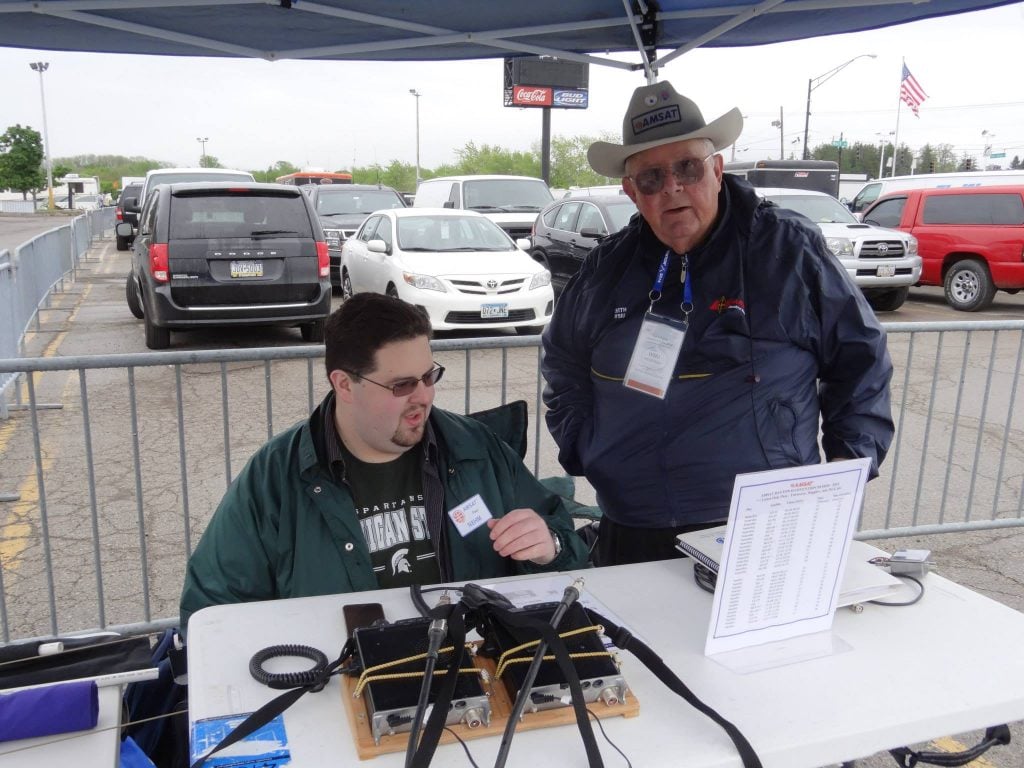10. Rub shoulders with 25,000 of your best friends at the largest hamfest in the United States, including all of the AMSAT Directors and senior officers. See the latest equipment from Icom, Yaesu, Kenwood, Flex, Alinco, M2, Arrow, and many other manufacturers of
amateur radio equipment and accessories. Take advantage of discounted pricing you won’t find anywhere else.
9. Find out how to organize a contact with the astronauts on the International Space Station for your local school or youth group from our Education and ARISS experts.
8. Pickup the latest AMSAT golf shirts, T-shirts, and hats. Get your copy of the updated “Amateur Satellite Frequency Guide” (laminated frequency chart) and Gould Smith’s just revised “Getting Started with Amateur Satellites” (book). We’ll also have assembled wide-band preamps and antennas that are great for portable operation.
7. See demonstrations of SatPC32 and MacDoppler satellite tracking software, and get your operational questions answered. Meet Don Agro, author of MacDoppler (Friday & Saturday, 2-3 p.m.). See a demonstration of the LVB Tracker, a computer interface to the Yaesu azimuth-elevation rotors. Talk with Mike Young, who has built more LVB Trackers than anyone else. Assembled LVB Trackers will be available.
6. Hear a team presentation at the joint AMSAT/TAPR dinner on the new AMSAT Ground Terminal (AGT). AGT is using Five and Dime (5 GHz uplink, 10 GHz downlink) technology that is being developed for the Phase 3E (P3E) HEO satellite, the Phase 4B (P4B) geosynchronous satellite, and the Cube Quest Challenge (CQC) lunar mission. While much of the P3E and P4B *satellite* development is classified, the AGT is all open source and public information.
5. Hear the latest on the *five* Fox satellites, P3E, P4B, CQC, the International Space Station, other current and future satellites, education news, and an AMSAT update at the AMSAT Forum Saturday, from 11:15 to 1:30.
4. Get one-on-one guidance on setting up your satellite station and making contacts at our “Beginner’s Corner”. Witness live demonstrations of contacts through satellites AO-7, AO-73, AO-85, FO- 29, SO-50, XW-2A, XW-2C, and XW-2F using handheld antennas.
3. Meet and interact with some of the Engineering Team members working on the Fox-1 satellites and our new Five and Dime AMSAT ground terminal. Learn all of the public information and get breaking news on the Virginia Tech plans for the Phase 3E and Phase
4B satellites.
2. Get satellite station and operating tips from some of the best satellite operators in the country, including John Papay K8YSE (1,575 grids confirmed), Doug Papay KD8CAO (1,159 grids), Drew Glasbrenner KO4MA (1,343 grids), Paul Stoetzer N8HM (450 grids), and Wyatt Dirks AC0RA (938 grids).
1. Receive special premiums when you join or renew your AMSAT membership at Dayton, including an updated “Amateur Satellite Frequency Guide” (laminated frequency chart), and special pricing on the SatPC32 satellite tracking software.
[ANS thanks Steve N9IP for the above information]

